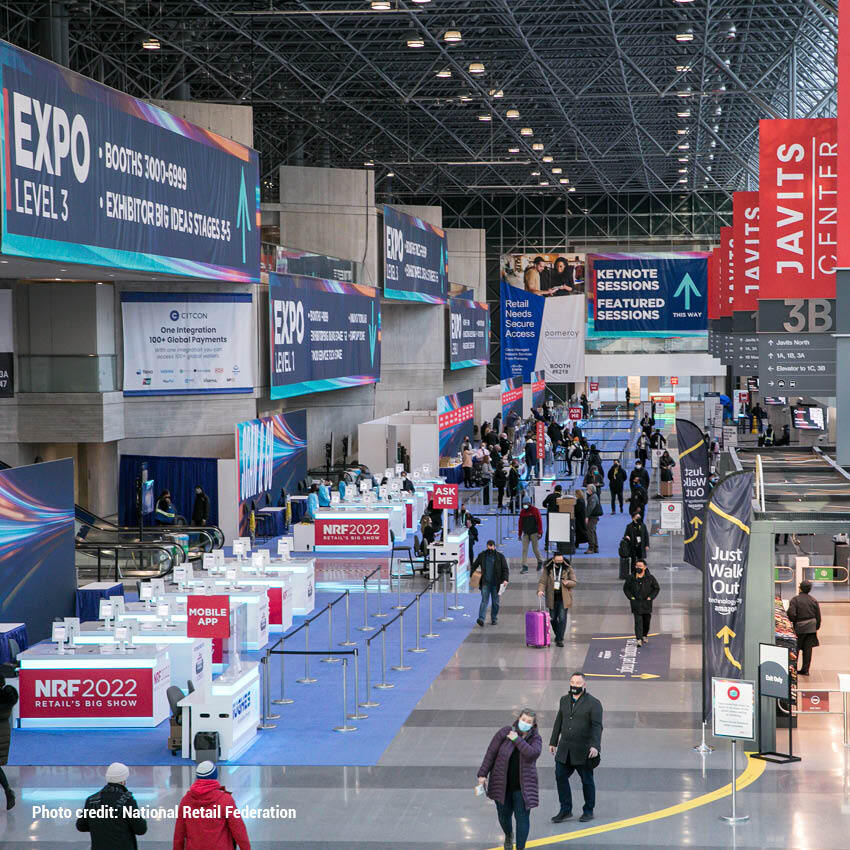NRF’s 2022 Big Show was far from big but it was the first in person gathering at a scale that the industry has seen since early 2020. Similar to what happened at CES this year, most of the big tech companies such as Intel and SAP did not show. Many of the medium sized firms also opted out. This opened up the opportunity for younger, smaller Innovators including tech startups to shine. Their show footprint and density were consistent with prior years, whereas the main exhibitor space had major gaps.
Coming off a year where shoppers endured endless lines to enter big box retailers along with painful issues of inventory and staffing, the range of digital technologies that track shoppers and detect logjams have become even more relevant.
The State of Retail
The uneven attendance of both brands and retailers raises the question about how representative this industry event really was. Did it accurately reflect the current and future state of retail?
With these thoughts in mind, I met up with Manolo Almagro, managing partner at Q division, a digital transformation consultancy. Manny has spent much of his career evaluating and deploying new tech in retail. When I asked him if there was really anything new at the show, he initially said no, from a tech standpoint. But we did agree that there were interesting iterations and integrations of technology at retail. In a race to become more nimble, retailers are taking a hard look at what can be autonomous, how to deploy talent, and ways to enhance the shopper experience, particularly when so much can be done from home.
Thought Leadership
Brian Cornell, CEO of Target, talked about the supply chain challenges that will continue into 2022. He says the short-term fix is to use technologies to gain better visibility into the pipeline to be able to anticipate future problems. Being able to be agile and pivot is key as supply chain wildcards continue to appear. More on that with TRR’s podcast. Cornell also discussed keeping the customer at the center of decision making and the importance of vendor partnerships like Ulta Beauty and Apple. Providing one-stop convenience and a wide variety of product categories to their shop is a unique value proposition for Target.
Pete Nordstrom, President and Chief Brand Officer at Nordstrom, discussed supply chain and the focus of looking at SKU management and understanding the number of units being put through an already strained supply chain. He says executives need to pay attention to the number of units being purchased along with margins and ROI of individual SKUs. Nordstrom also discussed the balance of digital and physical along with the importance of unified commerce; customers want to shop both online and in stores with the balance probably settling around 40 percent for online. He discussed high quality vendor partnerships and Nordstrom’s ability to bring in new vendors, and expanding product categories in existing brands that are the customers most loved brands. Speed to market for a fashion brand and for Nordstrom is a key differentiator and focus for the company. Lastly, the balance of off-price and full price at the Rack compared to the full line stores was a topic of debate. He said the challenge is to get the balance between the two at the right levels. He also noted that an online presence for Rack was not significant or widely needed.
Retail’s Metaverse
Speaking of home as mission central, this leads into the hype around the metaverse. As previously reported by TRR, the metaverse connects physical and digital worlds. As Dave Marcotte of Kantar put it “The metaverse is by definition a virtual creation with no gravity, and time can run backwards if need be. Very cool and great potential for innovation but conflicts directly with the 100 years of how retailers have taught shoppers to move and buy in a predictable space. So, replication of a store is user friendly, but lacks the excitement of drawing shoppers into a real new experiential shopping trip.”
Although it’s early days for the retail metaverse experience, Estee Lauder presented a Metaverse Experience for gamified beauty shopping. It offers a social shopping opportunity in a highly sensory landscape. Beauty is a category where augmented reality makes sense. Ditto for furniture. But it’s quite a leap to go from AR/VR deployments that assist in visualizing one’s lipstick or sofa selection to a full-up metaverse store. But it’s coming and next gens are already in the metaverse game.
Trending Innovations
Amar Singh from Kantar described the show as, “Most vendors are creating integrated ecosystems of automation tools, interactive digital shelves, and AI solutions to drive operational efficiencies and shopper engagement. The successful execution of predictive analytics and digital interaction within both metaverse and in-store environments will drive future success for retailers.”
Optimizing the physical space in the real world was a hot topic throughout the sessions and in the exhibitor halls. Coming off a year where shoppers endured endless lines to enter big-box retailers along with painful issues of inventory and staffing, the range of digital technologies that track shoppers and detect logjams have become even more relevant. They deliver value on both operations and customer experience fronts. And they are becoming more nimble and less expensive.
Rather than investing in new cameras and sensors, tech providers are leveraging existing equipment. For example, Pathr.ai is a technology company that uses spatial intelligence to best understand movement in physical spaces like stores, distribution centers, and shopping centers. It announced a partnership with VIVOTECK to deliver spatial intelligence to existing security cameras. Makes sense to optimize existing assets and ramp them up to improve the customer UX. “NRF is the premier retail event to connect with leading retailers and innovative minds in the industry. Pathr.ai was very proud to attend this year’s event despite the challenging times we’re still facing. It was a great experience to share more about our spatial intelligence solution that enables retailers to drive in-store growth and empower retail staff on the floor to effectively engage with their customers,” said George Shaw, Founder, and CEO of Pathr.ai.
On the voice commerce side, Vocalytics’ “listening” software can be deployed within existing camera infrastructure to capture shopper sentiment, monitor in-store safety, and identify upsell opportunities. Since many of the big tech companies were not present, developments of voice throughout commerce appeared to be underrepresented.
Understanding the value of how locations perform was a central theme among the champions of physical retail. Industry leaders and entrepreneurs are reimagining urban retail stores and malls as more shopping takes place online. With precise location data, Placer.ai analyzes traffic, movement, and performance of physical assets. This creates a robust dataset to help set leasing prices and guide redesigns. Benjamin Pitman, VP Sales Strategy and Development at Placer.ai was optimistic about their experience at the show, “NRF is such a significant part of the retail calendar, and having it back was valuable. While we’re certainly looking forward to seeing larger numbers in 2023, the ability to bring the retail community back together is an important step forward.”
Retail media continues to be another strong theme as the industry moves from hard-wired networks to dynamic content at the shelf edge. New to NRF, Tokinomo demonstrated how their in-aisle sensors can activate any FMCG product a shopper passes by. A far cry from the metaverse but perhaps one of the most practical uses of technology at the show. And media in its broadest term is on the minds of retailers as they become advertising, marketing and media agencies for their customers.
Agile is more than a buzzword. Clearly retailers had to become more agile to navigate the pandemic with heightened demand to continually adjust and redeploy resources. From physical optimization to the labor force, NFR 2022 showcased tools that help managers respond in real-time to store demands. With endless streams of information, the key is to use data to prioritize the right missions. Quorso presents a simple app for helping managers be more effective in supporting their employees. This is integral to a larger strategy of the need for C-suite leaders to get closer to the needs of their teams. CEO Julian Mills says, “We thoroughly enjoyed being in the Innovation Lab. By far and away the busiest area, with everyone wanting to know the best innovations NRF had selected for retail. In our conversations with retailers about Quorso, what resonated most was the urgent need to help their district and store leaders who are overwhelmed by the information and tasks being sent to them. It was a great forum to showcase our new features that personalize and map out every leader’s next-best-actions every day.”
Plum Slice (Digital Wave) demonstrated a software solution that provides product information management software enabling consistency in product information across all channels including digital and social media.
UK-based Dressipi uses AI and machine learning to personalize the shopping journey and data to improve the buying and merchandising process. Sarah McVittie, co-Founder says, “We didn’t know what to expect from our first time exhibiting at NRF but the feedback we got for our fashion AI technology from both retailers and other exhibitors has been exceptional. The turnout may have been low but those retailers who were there were buying. We had good, high-quality meetings with key retailers in the fashion and apparel space. We saw three major shifts that were apparent at NRF: 1. The permanent shift to online (10 percent to 20 percent in the U.S., 30 percent+ in UK) is driving a greater demand for data/algorithmic-led retailing. 2. All retailers we spoke to were investing in digital and personalized relevant customer journeys. 3. The shift from monolithic platforms to headless commerce is definitely underway with the larger retailers interested in the APIs we can deliver. Sustainability was a key theme too but easier to swallow if it can be delivered whilst still growing the revenue and profit line. As the only fashion/apparel-specific personalization engine we were delighted to be able to showcase the huge benefits we bring to fashion retailers including increasing incremental revenue by 12 percent and reducing returns by 15 percent. We are also the only sustainable choice as we are able to reduce return rates and increase full-price sell-through rates at the same time. And obviously we LOVED New York. See you again, same time, same place in 2023!”
2022 Themes
On a macro level, NRF focused on emerging tech, innovation, automation, integration, and inclusion.
- Unified commerce and enabling technologies support the synergistic approach across various platforms including digital, physical and social media.
- Hybrid shopping as a result of pandemic accelerated shopping behaviors has established online shopping, curbside pick-up and buy-online-pick-up in store with a plethora of technologies to support the hybrid shopping models.
- Purpose-driven consumerism continues to grow in terms of the number of consumers that look for companies and brands that align with their own values and promote health and wellness. Viral commerce and the rise of social commerce will act as a catalyst for growth in purpose-driven consumerism…consumers become evangelists for brands and retailers who are making a difference beyond profits.
- Sustainability is a focus for consumers and the gap of intent of purchasing sustainable products and the action of doing so will lessen. In a recent study by IBM in association with the NRF, showed that while 50 percent of consumers say they will spend more on sustainable products, fewer than 1 in 3 consumers actually spent more than half of their purchase on sustainable products.
- As a final note, there was an entire hall dedicated to inclusion along with presentations along these lines. The imperative is to get the retail organizations to reflect the diversity of their customer base and ensure their workforce mirrors that diversity. This is a means to understanding the diversity of shopper needs and challenges and ensuring that a retail organization is in touch with all its stakeholders




